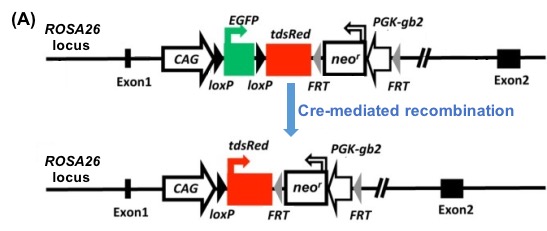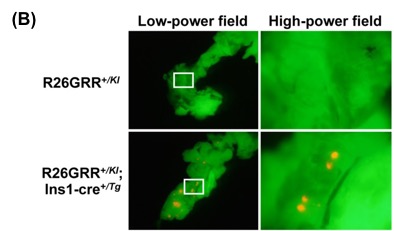 |
October 2018 Mouse of the Month |
|
Green-to-red fluorescent-convertible Cre-reporter mice C57BL/6N-Gt(ROSA)26Sor<tm1(CAG-EGFP/DsRed)Utr>/Rbrc (RBRC04874)Courtesy of Fumihiro Sugiyama, Ph.D. (A) Cre-recombination strategy in R26GRR mice. |
|
Cre recombinase derived from P1 bacteriopharge specifically recognize short DNA sequences (loxP site) and cause inducible genome alternation. The Cre/loxP system have been widely used to study gene function in vivo as conditional knockout mice. Successful Cre-mediated recombination in mice depends on accurate Cre expression in Cre-driver mice. R26GRR mice are knock-in mice from C57BL/6N ES cells, in which Cre-reporter cassette into ROSA26 locus. As Cre-reporter mice, R26GRR mice are useful for evaluation of Cre expression pattern in Cre-diver mice (1). R26GRR mice make possible to monitor Cre-mediated recombination by dual fluorescent signal with different wavelengths (EGFP and tdsRed). Depositor of R26GRR mice (Sugiyama) and colleagues already utilized R26GRR mice to characterize some novel site-specific Cre-driver mice, which they generated (2, 3, 4). They revealed that R26GRR mice show green fluorescence in all organs examined before and red fluorescence in only predictable site after Cre recombination. |
| Depositor | : | Laboratory Animal Resource Center, University of Tsukuba and RIKEN BioResource Center |
|
| Strain name | : | C57BL/6N-Gt(ROSA)26Sor<tm1(CAG-EGFP/DsRed)Utr>/Rbrc | |
| RBRC No. | : | RBRC04874 | |
| References | : | [1] | Hasegawa Y, Daitoku Y, Sekiguchi K, Tanimoto Y, Mizuno-Iijima S, Mizuno S, Kajiwara N, Ema M, Miwa Y, Mekada K, Yoshiki A, Takahashi S, Sugiyama F, Yagami K. Novel ROSA26 Cre-reporter knock-in C57BL/6N mice exhibiting green emission before and red emission after Cre-mediated recombineation. Exp Anim.; 62(4): 295-304, 2013. |
| [2] | Hasegawa Y, Daitoku Y, Mizuno S, Tanimoto Y, Mizuno-Iijima S, Matsuo M, Kajiwara N, Ema M, Oishi H, Miwa Y, Mekada K, Yoshiki A, Takahashi S, Sugiyama F, Yagami K. Generation and characterization of Ins1-cre-driver C57BL/6N for exclusive pancreatic beta cell-specific Cre-loxP recombination. Exp Anim.; 63(2): 183-191, 2014. | ||
| [3] | Hasegawa Y, Hoshino Y, Ibrahim AE, Kato K, Daitoku Y, Tanimoto Y, Ikeda Y, Oishi H, Takahashi S, Yoshiki A, Yagami K, Iseki H, Mizuno S, Sugiyama F. Generation of CRISPR/Cas9-mediated bicistronic knock-in ins1-cre driver mice. Exp Anim.; 65(3): 319-327, 2016. | ||
| [4] | AI-Soudy AS, Nakanishi T, Mizuno S, Hasegawa Y, Shawki HH, Katoh MC, Basha WA, Ibrahim AE, EI-Shemy HA, Iseki H, Yoshiki A, Hiromori Y, Nagase H, Takahashi S, Oishi H, Sugiyama F. Germline recombineation in a novel cre transgenic line, Prl3b1-Cre mouse. Genesis; 54(7):389-397, 2016. | ||
| October 2018 Contact: Saori Mizuno, Ph.D. Experimental Animal Division, RIKEN BioResource Research Center All materials contained on this site may not be reproduced, distributed, displayed, published or broadcast without the prior permission of the owner of that content. |






